Understanding the Dangers of a Malfunctioning Garage Door
A malfunctioning garage door may seem like a minor issue, but it can actually pose serious risks to your safety. The garage door is not only a convenient way to access your vehicles and belongings, but it also serves as a vital security measure for your home. When the door is not functioning properly, it can compromise the safety of your family and property.
One of the primary dangers of a malfunctioning garage door is the risk of accidents and injuries. A faulty garage door may suddenly come crashing down, causing severe harm to anyone or anything in its path. This is especially hazardous if you have small children or pets who may be playing near the door. In addition, a malfunctioning garage door can also lead to accidents when you try to manually open or close it, as the mechanism may not be properly aligned or balanced. Therefore, it is crucial to address any issues with your garage door promptly to avoid these potential dangers.
Identifying Common Issues of a Malfunctioning Garage Door
One common issue that’s indicative of a malfunctioning garage door is if the door is making unusual noises during operation. Grinding or squeaking sounds could be a sign of worn-out or misaligned components. If your garage door is moving slowly or jerking, it may indicate a problem with the motor or tracks. Another red flag is if the door doesn’t respond consistently to your commands, such as opening or closing halfway and then reversing. These issues should not be ignored, as they can lead to more serious problems if not addressed promptly.
Another sign of a malfunctioning garage door is if it becomes unbalanced. You can check this by disconnecting the door from the opener and manually lifting it halfway. If it doesn’t stay in place but either falls or rises on its own, it indicates that the springs or cables may be damaged or improperly adjusted.
It’s important to note that attempting to fix or adjust these components yourself can be dangerous and should be left to professionals. Moreover, if you notice any visible damage or warping on the door panels or excessive gaps between the door and the frame, it could be a sign of structural issues. In such cases, calling a garage door repair technician is essential to ensure not only your safety but also the longevity of your garage door.
Staying Safe Inside: Precautions to take when your garage door gets stuck in the closed position
When your garage door gets stuck in the closed position, it’s important to take precautions to ensure your safety. In other words, resist the temptation to perform any DIY fixes as they can lead to further damage and pose an even greater risk. Instead, start by disconnecting the garage door opener from the power source to prevent any accidental activation while you’re inside.
Next, check for any visible obstructions or debris that may be preventing the door from opening. Clearing away any objects in the door’s path can help alleviate the issue. However, exercise caution and avoid placing your hands or fingers near the tracks or any moving parts. In the event that the door remains stuck, it’s best to contact a professional garage door technician who has the knowledge and experience to safely resolve the problem. Attempting to repair a stuck door on your own without proper training can result in injuries or further complications.
Dealing with a Jammed Door: Handling a garage door that won’t open
A jammed garage door can be a frustrating and potentially dangerous situation, so it’s important to approach the problem with caution to ensure your safety. The first step in safely handling a jammed garage door is to assess the situation. Take a moment to inspect the door and look for any visible signs of damage or obstructions. It’s also a good idea to check the remote control, keypad, or wall switch to ensure they are functioning properly. If everything appears to be in order, proceed to the next step.
When the Door Won’t Close: How to protect yourself and your belongings when your garage door won’t fully close
When your garage door won’t fully close, it’s important to take immediate action to protect yourself and your belongings. Leaving your garage door partially open can leave your home vulnerable to intruders and can also expose your possessions to the elements. To ensure your safety and security, start by checking for any obstructions in the garage door track. Sometimes, debris or objects can get lodged in the track, preventing the door from closing properly. Clearing any obstructions and testing the door again may resolve the issue.
If checking for obstructions doesn’t solve the problem, it’s crucial to disable the automatic opener to prevent any further attempts to close the door. Just pull the red emergency release handle, typically located near the opener unit. By doing so, you will disconnect the door from the opener and allow it to be operated manually.
However, it’s important to exercise caution when manually operating the door, as it can be heavy and pose a risk of injury. Use both hands and be mindful of your surroundings to avoid accidents. Once the door is fully closed, keep it secured with additional locks or reinforcements until a professional can assess and repair the issue.
Coping with Broken Springs: Safety measures to follow when dealing with a garage door with broken springs
When it comes to dealing with a garage door with broken springs, safety should be your top priority. Broken springs can cause the garage door to become heavy and unbalanced, increasing the risk of accidents or injuries. To ensure your safety and the safety of others, it is important to follow some key safety measures.
It’s essential to refrain from attempting to fix or replace the broken springs on your own unless you have proper training and experience in garage door repairs. The high tension in the springs can make them extremely dangerous to handle without the necessary knowledge and tools. Instead, reach out to a professional garage door repair service to safely handle the situation. They have the expertise to assess the problem, determine the appropriate solution, and carry out the repair or replacement safely.
Addressing Sensor Problems: Tips for troubleshooting and fixing malfunctioning garage door sensors
Sensor problems can be a frustrating issue to deal with when it comes to your garage door. A malfunctioning sensor can prevent the door from closing properly, leaving your belongings vulnerable to theft or damage. However, there are a few troubleshooting tips that can help you address these sensor problems on your own.
Start by ensuring that the sensors are clean and free from any debris or obstructions. Dust, dirt, or spider webs can interfere with the sensors’ ability to detect objects in the door’s path. Use a soft cloth or a gentle brush to clean the sensors thoroughly.
Additionally, check if there are any visible damages or loose connections. Sometimes, a simple repair or tightening of wires can resolve the issue. If cleaning and inspecting the sensors doesn’t solve the problem, you may need to realign them. Garage door sensors work by sending an infrared beam across the path of the door. If this beam is interrupted, the sensor signals the door to stop closing. To realign the sensors, you can try adjusting their position so that the infrared beams are aligned properly. Be sure to refer to the manufacturer’s instructions for specific guidance on how to adjust and align the sensors.

Power Outages and Emergency Release: Knowing how to manually operate your garage door during power failures
During a power outage, being able to manually operate your garage door becomes essential for your safety and convenience. Knowing how to do it can save you from being stuck inside your garage or having your car trapped outside. The emergency release mechanism is designed to disengage the garage door from the opener, allowing you to manually open and close it. To manually operate your garage door during a power failure, locate the emergency release cord, usually hanging from the garage door opener rail. Pulling this cord will disengage the opener’s drive mechanism.
Once disengaged, you can manually lift the door by grasping it with both hands and lifting it upward. Be cautious of the weight, as garage doors can be heavy. Similarly, when closing the door, carefully guide it down until it is fully closed. It is important to note that once power is restored, you will need to re-engage the garage door opener by pulling the emergency release cord in the opposite direction.
What can happen if my garage door malfunctions?
A malfunctioning garage door can pose serious risks to your safety, such as potential injuries and property damage.
How can I identify if my garage door is not functioning properly?
Look out for signs like unusual noises, slow operation, jerky movements, or difficulty in opening and closing.
What precautions should I take if my garage door gets stuck in the closed position?
Stay safe inside by keeping the area clear, avoiding any attempts to force it open, and contacting a professional for assistance.
What should I do if my garage door won’t open?
Follow our step-by-step guide to safely handle a jammed garage door, ensuring you don’t put yourself or others at risk.
How can I protect myself and my belongings if my garage door won’t fully close?
Take measures such as locking the door manually, securing the area, and considering alternative storage options if necessary.
What safety measures should I follow when dealing with a garage door with broken springs?
It’s crucial to avoid attempting any repairs yourself and immediately contact a professional to address the issue.
Any tips for troubleshooting and fixing malfunctioning garage door sensors?
Check for obstructions, ensure they are aligned properly, and consider cleaning them to see if that resolves the problem. If not, contact a professional for assistance.
How can I manually operate my garage door during power failures?
Familiarize yourself with the emergency release cord and lever mechanism, which allows you to open and close the door manually when there’s no power.
We Will Return Your Garage Door To Working Order
Dealing with a malfunctioning garage door can be a complex and potentially dangerous situation, particularly when it involves intricate components like springs, sensors, or power systems. While some minor troubleshooting can be attempted, the safest and most efficient course of action is often to seek professional assistance. That’s where our team at 24 Hour Garage Door Services & Repair comes in. With our expertise and around-the-clock availability, you can rest assured that any garage door issue you encounter, no matter how big or small, will be handled promptly and effectively.
Remember, your garage door is not just a convenience but a crucial part of your home’s security and functionality. Don’t let a malfunction compromise the safety of your family or the security of your property. Whether it’s an emergency situation or routine maintenance, 24 Hour Garage Door Services & Repair is equipped to provide top-notch service and peace of mind. Keep our contact information handy for those unexpected breakdowns or for regular check-ups to ensure your garage door continues to operate smoothly and safely.

